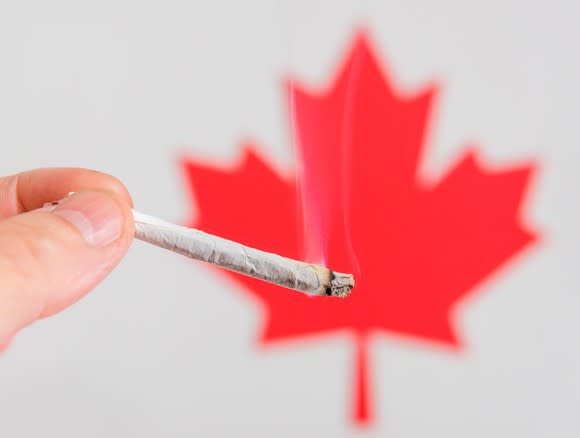Truth Be Told, Canadian Marijuana Stocks Don't Need the U.S. to Thrive
There's a good reason the legal marijuana industry is known as the "green rush": It has a lot of people seeing dollar signs. Most marijuana stocks with a market cap of $200 million or higher have doubled or tripled in value over the trailing year.
These returns come on the heels of exceptionally strong sales growth in the industry, and a marked shift in the public's perception of pot. Regarding the former, leading cannabis research firm ArcView is forecasting North American sales growth of 26% through 2021. If this prediction proves accurate, we could be looking at almost $22 billion in legal annual weed sales very soon.

Image source: Getty Images.
We're also witnessing growing support for legalization among the public. Since April 2017, four surveys in the U.S. have found overwhelming support for green-lighting marijuana, with almost two-thirds of respondents in the October 2017 Gallup poll in favor of legalizing the drug. That's up from just 25% in 1995, the year before California became the first of what are now 29 states to have legalized medicinal cannabis.
The cannabis industry's potential is capped in the U.S.
Yet, in spite of incredible stocks gains, sales growth, and consumer favorability, the path to prosperity in the marijuana industry has a very low ceiling in the United States. That's because pot is still classified as a Schedule I substance, meaning it's entirely illegal, has a high potential for abuse, and has no recognized medical benefits.
This scheduling comes with a number of adverse impacts for businesses operating in the U.S. pot industry. For example, profitable cannabis companies might be forced to pay an effective tax rate of up to 90% considering that U.S. tax code 280E disallows them from taking normal corporate income tax deductions. They also have little or no access to basic banking services, ranging from loans and lines of credit to something as simple as a checking account.

Image source: Getty Images.
Additionally, Attorney General Jeff Sessions has signaled his intent to wage war on the domestic marijuana industry. Sessions, who has openly called for the repeal of the Rohrabacher-Farr Amendment, which protects medical cannabis businesses from federal prosecution, recently announced that the Cole memo would be rescinded. The Cole memo was a loose set of rules that legalizing states agreed to abide by in order to keep the federal government off their backs. It included aspects such as keeping adolescents away from pot, and ensuring that cannabis grown within a state stayed within that state. Without this memo in place, state prosecutors will have the discretion to go after marijuana violations in legal states.
These recent actions by Sessions, along with the GOP-led Congress making no effort whatsoever to even consider reforming marijuana's Schedule I classification, has been viewed by many as a major disappointment. In fact, word of Sessions rescinding the Cole memo sent marijuana stocks tanking by 15% to 33% across the board on Jan. 4.
The harsh truth: Canadian marijuana stocks don't need the U.S. to thrive
Though the U.S. could be the most lucrative marijuana market in the world if the drug were legal at the federal level, the truth of the matter is that Canadian marijuana stocks, which have been leading the charge higher for more than a year now, don't actually need access to the U.S. market to be successful. They already have plenty of catalysts and demand to keep them busy.
To begin with, medical cannabis has been legal in Canada since 2001, and it's being overseen by Health Canada. This regulatory agency has done a remarkable job of keeping production and licensing under control, such that some growers (MedReleaf (NASDAQOTH: MEDFF) and Aphria (NASDAQOTH: APHQF)) have been profitable on an annual basis solely because of medical weed sales. In fact, a press release from Health Canada in May 2017 notes that eligible patient enrollment in the country's medical marijuana program was growing at a rate of 10% per month.

Image source: Getty Images.
Beyond medical cannabis, Canada also appears to be on the verge of legalizing recreational marijuana in July 2018. Though legislation introduced by Prime Minister Justin Trudeau faced initial objections, those have been mostly overcome. Progressive members outnumber conservatives in parliament, and recently a tax-sharing deal was reached with Canada's 13 provinces regarding legal weed sales. Should pot become legal for adult use in July, it could be generate up to $5 billion annually in sales once fully ramped up.
Third, Canada is also among a small group of nations that's authorized the export of dried cannabis to legal medical weed countries. For instance, Germany recently legalized medical marijuana, but it has virtually no domestic growing capacity. It's accounting for this, for the time being, by importing dried cannabis from Canadian growers.
The Canadian growing industry is also quite consolidated. Whereas the U.S. market is dominated by smaller mom-and-pop-type businesses, the Canadian weed industry is mostly comprised of large and mid-sized growers. While that may not appeal to everyone, it's the perfect formula for investors and low production costs.
Finally, Canadian growers have moved beyond just dried cannabis. The market for cannabis oils is thriving in our neighbor to the north, and cannabis oils naturally come with higher price points and juicier margins for the companies that sell them.

Image source: Getty Images.
Expansion, as far as the eye can see
As the result of this "perfect storm" of legal weed demand in Canada, Canadian marijuana stocks are ramping up their growing capacity at a rapid pace. Below are just some of the major projects currently under construction or development from the industry's biggest players.
Canopy Growth Corp. (NASDAQOTH: TWMJF): According to the company's second-quarter operating results, it has 4 million square feet of capacity under construction or in development in British Columbia, with the option to lease another 1.7 million square feet in B.C. Canopy is expected to have the highest market share of any medical or recreational grower.
Aurora Cannabis (NASDAQOTH: ACBFF): The company's flagship project is Aurora Sky, a highly automated 800,000 square foot facility that's expected to be completed in mid-2018. When ramped up, Aurora Sky should be capable of producing 100,000 kilograms of dried cannabis a
Aphria: The aforementioned Aphria is working on a more than $100 million four-phase project designed to boost its growing capacity to 1 million square feet. It anticipates being able to produce in the neighborhood of 100,000 kilograms of dried cannabis a year, albeit its full-year production estimates have been raised multiple times over the past year.
MedReleaf: MedReleaf, which went public last year, is using its initial public offering proceeds to expand growing capacity at its Bradford, Ontario, facility. It's also a market leader in high-margin cannabis oil sales.
OrganiGram Holdings (NASDAQOTH: OGRMF): Though OrganiGram's pockets aren't as deep as say Aurora Cannabis, it's nonetheless moving forward with plans to more than double its growing capacity at its Moncton, New Brunswick, location to 429,000 square feet. Such a move is expected to more than triple its annual dried cannabis production to 65,000 kilograms from around 20,000 OrganiGram also happens to be the cheapest marijuana stock on a fundamental basis.
Though these growers are reinvesting most of their positive cash flow back into capacity expansion, it looks to be only a matter of time before they begin delivering healthy quarterly profits, assuming full legalization moves forward in Canada.
More From The Motley Fool
Sean Williams has no position in any of the stocks mentioned. The Motley Fool has no position in any of the stocks mentioned. The Motley Fool has a disclosure policy.

 Yahoo Finance
Yahoo Finance 